Whether you’re fine-tuning your bike for superior performance with monster brakes, a trick suspension setup, or an exotic exhaust system, or simply acknowledging the inevitability of wear and tear, your overall riding experience becomes significantly more enjoyable when rolling confidently on the right set of tires. These unsung heroes of your journey, much like carefully chosen boots or a helmet, smoothly align with your distinct riding style.
Yet, a motorcycle tire transcends being merely an air-filled rubber ring; it stands as a sophisticated piece of engineering, with diverse shapes and forms designed to conquer a multitude of challenges — from ensuring optimal traction on smooth asphalt roads, gravel paths, and wet surfaces to providing stability during sharp cornering, and from withstanding the rigors of braking to resisting degradation.
To offer you a comprehensive understanding of the diverse behaviors exhibited by different tires, let’s explore the various types of motorcycle tires based on their specific applications. But first,
Top-Rated Motorcycle Tires: Your Ultimate Guide to Performance and Specialty Picks
| Tire Model | Category | Get Yours |
| Michelin Road 6 | Best All-Around | RevZilla | MotoSport | Amazon |
| Dunlop American Elite | Best Street | RevZilla | MotoSport | Amazon |
| Dunlop Q3+ Sportmax | Best Sport/Track | RevZilla | MotoSport | Amazon |
| Metzeler Cruisetec | Best Cruiser | RevZilla | MotoSport | Amazon |
| Continental Trail Attack 3 | Best Dual Sport/Adventure | RevZilla | MotoSport | Amazon |
| Bridgestone M59 | Best Off-Road/Motocross | RevZilla | CycleGear | Amazon |
| Pirelli Angel GT II | Best Sport Touring | RevZilla | MotoSport | Amazon |
| Shinko 777 | Best Budget-Friendly | RevZilla | MotoSport | Amazon |
8 Motorcycle Tire Types You Need to Know About During Your Selection Process
Shifting our attention from the aesthetics of personal style to the technical intricacies, the key factors distinguishing one tire type from another lie in its rubber compound and tread pattern. These elements, in turn, adapt to the specific environment and conditions in which the tire will be used. Through the application of appropriate tire technology—silica compounds for enhanced grip and multi-compound construction for optimized traction and durability, among others—you can be confident that your motorcycle will exhibit superior handling and traction.
Now, let’s delve into the 8 main tire options available in the market and examine the specific advantages they bring to enhance your motorcycle’s performance:
| Motorcycle Tire Types | Main Characteristics | Rubber Compound | Tread Pattern |
|---|---|---|---|
| Street/Standard Tires | Everyday Reliability | Inexpensive hard or medium compound rubber | Symmetrical, optimized for all-weather use |
| Sport Tires | The Corner Carvers | Soft compound rubber | Limited, prioritizes larger surface area for grip |
| ADV/Dual Sport Tires | Bridging The Gap | Dual compound, knobby for off-road, less aggressive for on-road | Unidirectional, adapted to on-road and off-road needs |
| Touring Tires | Balancing Mileage And Traction | Hard compound rubber, bias-ply construction | Flatter profile, optimized for straight-line stability |
| Cruiser Tires | Ride In Style | Harder compound rubber | Deeper tread for stability, optimized for extended mileage |
| Sport Touring Tires | A Symphony Of Performance And Endurance | Complex compound with softer sides | Asymmetrical, adaptive to diverse terrains |
| Off-Road/Motocross Tires | Conquering Terrain | Soft compound with knobby lugs | Knobby, varies for soft and hard terrains |
| Racing Tires/Slicks | Unleashing Precision | Soft compound rubber | Treadless for maximum contact patch |
1. Street/Standard Tires: Everyday Reliability
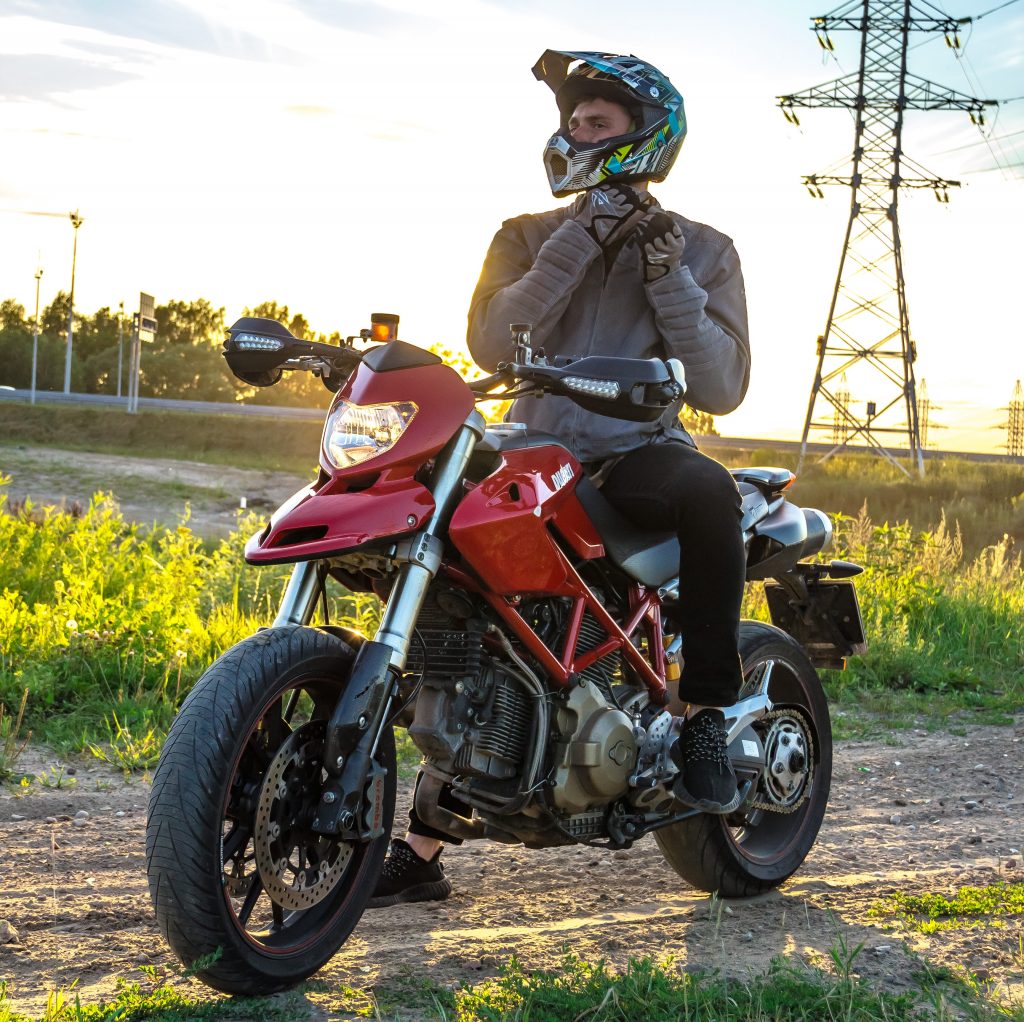
Street tires, the default choice for most everyday motorcycles, prioritize durability and reliability over ultimate performance. While they may not offer the best grip, they provide a cost-effective solution that withstands the test of time. Ideal for daily commuting, these tires strike a balance between performance and longevity.
Durability and Affordability
Street tires address the fundamental requirements of typical low-powered motorcycles, made from inexpensive hard or medium compound rubber. Emphasizing durability and reliability ensures a reasonable price point, making them a practical choice for everyday riders.
Commuting Comfort
Tailored for everyday commuting, standard tires deliver a reliable and comfortable ride. Well-suited for routine city travel, they can even handle occasional intercity trips. But they may not be the optimal choice for aggressive cornering or extremely wet or slippery conditions.
Versatility for Standard Needs
Unless you have specific and extreme requirements, street tires serve as a suitable choice for standard motorcycles. Meeting the basic needs of everyday riding, they offer a well-rounded solution for riders without specialized demands.
Merits:
- Enduring Durability: Engineered to withstand daily wear and tear, ensuring a prolonged lifespan.
- Economical Choice: A budget-friendly option without compromising essential performance attributes.
- Balanced Performance: Offers a versatile balance suitable for typical commuting scenarios.
Drawbacks:
- Modest Performance: May lack the peak grip and performance required for aggressive riding styles.
- Suboptimal for Specialized Conditions: Less suited for aggressive cornering or extremely challenging weather conditions.
Here are the standard metric sizes for common street tires, both front and rear:
| Front Size | Alpha | Inch | Rear Size | Alpha | Inch |
|---|---|---|---|---|---|
| 80/90 | MH90 | 2.50/2.75 | 110/90 | MN90 | 3.75/4.25 |
| 90/90 | MJ90 | 2.75/3.00 | 120/80 | MP85 | 4.50/4.75 |
| 100/90 | MM90 | 3.25/3.50 | 120/90 | MP85 | 4.50/4.75 |
| 110/90 | MM90 | 3.75/4.00 | 130/80 | ---- | 5.00/5.10 |
| 120/80 | ----- | 4.25/4.50 | 130/90 | MT90 | 5.00/5.10 |
| 120/90 | MR90 | 4.25/4.50 | 140/80 | ---- | 5.50/6.00 |
| 130/90 | MT90 | 5.00/5.10 | 140/90 | MU90 | 5.50/6.00 |
Feeling puzzled? Take a moment to explore my in-depth guide on understanding motorcycle tire sizes.
2. Sport Tires: The Corner Carvers
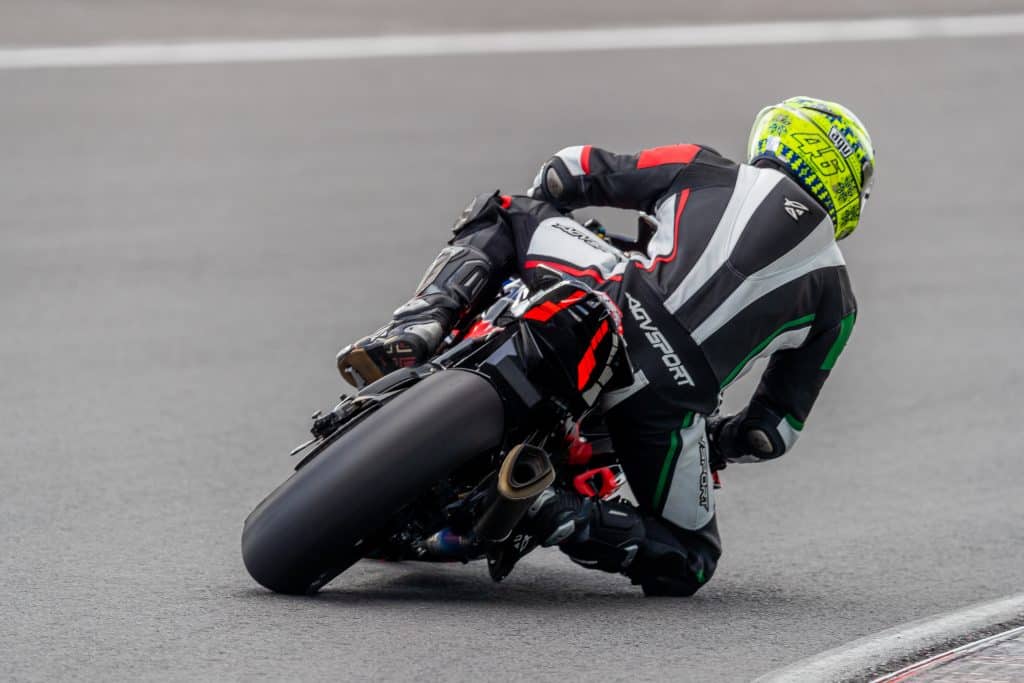
Sport tires, specifically designed for lightweight corner carving and high-performance street and track bikes, represent a pinnacle in tire technology that enhance performance and rider confidence.
Lightweight Construction for Agile Handling
Sport tires distinguish themselves through a lighter construction. Made with softer compounds and a rounded shape, they maximize grip, instilling confidence in riders navigating tight corners—crucial for the aggressive cornering capabilities of sport bikes.
Stiff Radial Carcass for Stability
The carcass, the foundational structure beneath the tread, incorporates a stiffer radial construction, ensuring stability, support, and effective heat dissipation—critical elements during high-speed cornering and braking, where tires experience the most stress.
Minimalist Tread Patterns for Maximized Contact
Sport tires typically feature a limited number of tread patterns, prioritizing a larger surface area for grip while maintaining adaptability to various wet weather conditions.
Varied Profiles for Diverse Riding Preferences
While most sport tires adopt a rounded profile, casual variants have a flatter tread profile, serving a dual purpose: preventing excessive leaning in corners and enhancing stability during straight-line riding. Meanwhile, aggressive types adopt a more angular design, promoting a responsive and eager turn-in.
Such versatility caters to riders who prefer a more controlled approach to cornering or emphasize stability in different riding scenarios.
Grip vs. Longevity
Despite unparalleled grip, sport tires are not synonymous with longevity. The emphasis on performance and traction often comes at the expense of extended tire life. Riders who prioritize maximum grip and agility should be aware of the trade-off and consider their riding preferences when selecting tires.
Merits:
- Dynamic Grip Performance: Unmatched traction for riders seeking dynamic and aggressive maneuvers.
- Ideal for High-Performance Bikes: Suitable for those with a penchant for high-performance street bikes.
- Confident Cornering: Engineered to instill confidence during challenging cornering scenarios.
Drawbacks:
- Limited Longevity: Not the optimal choice for riders prioritizing tire longevity.
- Less Suited for Long-Distance Riding: Tailored for dynamic performance rather than extended touring.
3. ADV/Dual Sport Tires: Bridging the Gap
Adventure bikes, made for extensive travel across diverse terrains, require specialized tires capable of effortlessly transitioning between smooth highways and challenging off-road landscapes.
Versatile Construction for Mixed Terrains
ADV tires strike a delicate balance, delivering a smooth highway performance while featuring an optimal tread pattern for off-road excursions. With specified percentages like 80% off-road / 20% on-road, ADV/dual sport tires cater to the diverse needs of adventure riders, providing versatility for varied riding experiences.
Tread Pattern Variability
Dual-sport tires vary in tread patterns, with knobby tires for aggressive off-road use and less aggressive ones for road performance with occasional light off-roading.
Take Pirelli’s Scorpion Trail II tires, for instance, tailored for 87% on-road and 13% off-road use, striking a good balance between on-road comfort and off-road capability. These tires work well with adventure bikes like the KTM Super Adventure 1290, Adventure 1190 (K-spec for OE tire), and Ducati Multistrada 1200 Enduro (D-spec for OE tire).
Intended Usage Percentages
These percentages offer a clear indication of a tire’s specialization. Michelin Tracker, with a usage ratio of 80% off-road and 11% on-road, suits adventure riders prioritizing extensive off-road experiences. The knobby construction ensures superior traction in challenging terrains like loose dirt, sand, or mud surfaces.
Merits:
- Versatile Performance: Designed for both on-road and off-road adventures.
- Clear Indications: Percentage indications guide riders in selecting tires tailored to their preferred riding environments.
- Knobby or Less Aggressive Options: Provides flexibility based on individual off-road preferences.
Drawbacks:
- Compromised Specialization: While versatile, dual-sport tires may not excel as much in extreme on-road or off-road scenarios like very wet or icy surfaces.
4. Touring Tires: Balancing Mileage and Traction
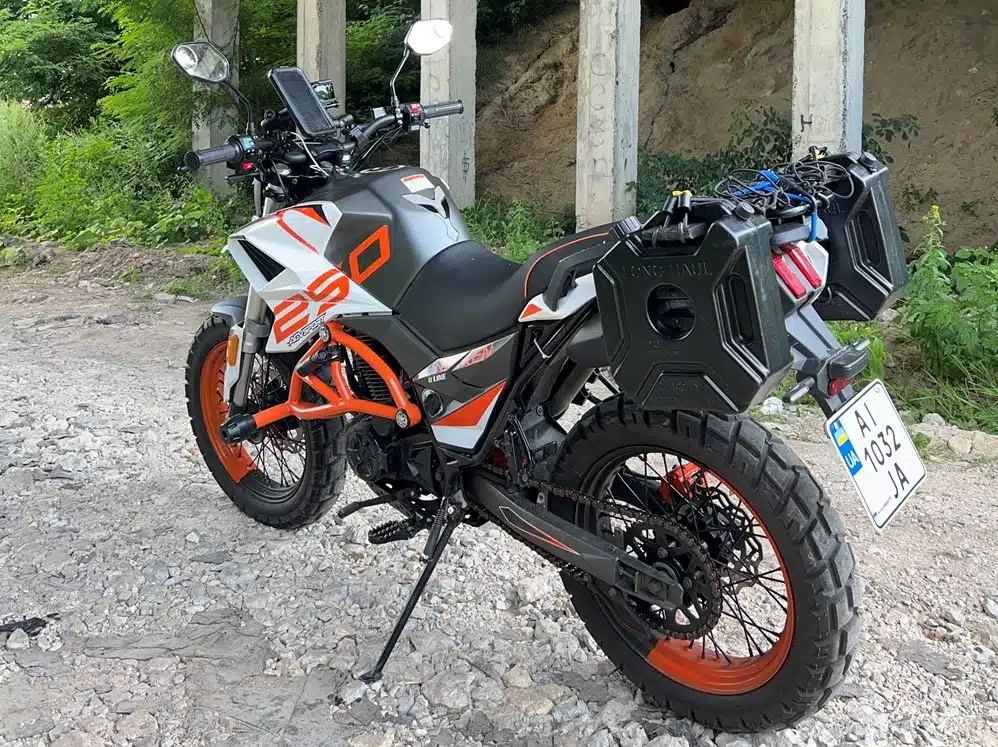
Touring tires stand apart from their sportbike counterparts by artfully harmonizing longevity and traction, specifically designed for riders embarking on extensive journeys. While sharing commonalities with sport tires, touring tires boast a construction tailored for extended mileage without compromising on-road performance.
Optimized for Long Mileage and Traction
Touring tires skillfully balance durability and traction, incorporating a slightly flatter profile to enhance straight-line stability during extended rides. Utilizing a harder dual compound (soft shoulders for edge grip, hard center for mileage), these tires prioritize longevity and extended range, albeit with a minimal compromise on immediate grip.
Bias-Ply Construction for Comfortable Riding
Distinguished by a bias-ply construction, touring tires feature internal belts made from fibers like polyester, aramid, or fiberglass. This innovative design enhances the tire’s ability to absorb road bumps, ensuring a smoother and more comfortable ride, especially vital for the demands of cross-country touring.
Exceptional Wet Weather Performance
Touring tires shine in wet conditions, equipped with a substantial tread that not only boosts traction but also efficiently disperses water from the contact patch, ensuring enhanced stability and control even in challenging weather scenarios.
Merits:
- Extended Mileage: Designed for riders embarking on long-distance journeys.
- Stability during Straight-Line Riding: Flatter profile enhances stability during extended periods of straight-line cruising.
- Comfortable Ride: Bias-ply construction absorbs road bumps for a smoother overall ride.
Drawbacks:
- Reduced Grip: Sacrifices some grip compared to softer tire compounds.
- Less Suited for Aggressive Cornering: Made for comfort and stability rather than aggressive cornering maneuvers.
5. Cruiser Tires: Ride in Style
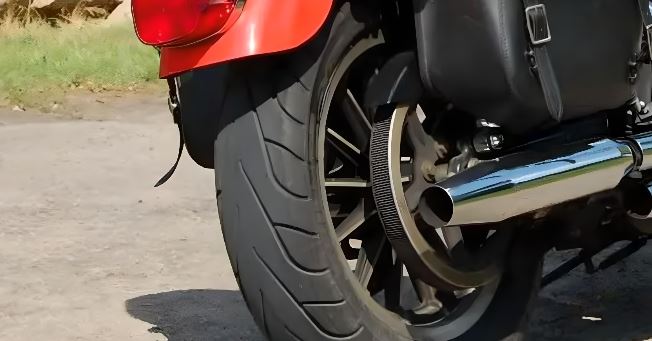
Cruiser tires and touring tires embody distinct characteristics, reflecting the specialized needs of their respective motorcycles. While touring motorcycles prioritize cornering capability, cruiser-style motorcycles are engineered for unparalleled straight-line stability, influencing their unique tire construction and design.
Deeper Tread Depth and Harder Compounds
To withstand heavy bike weight and provide prolonged mileage, cruiser tires feature a combination of deeper tread depth and harder compounds, similar to the characteristics of touring tires, minimizing wear and extends tire life.
Heavier Build for Stiffness
Due to the use of harder compounds, cruiser tires carry more weight than other types, incorporating stiffer sidewalls to handle additional loads from saddlebags or tandem riding.
Long Mileage with Good Wet Weather Traction
Like touring tires, cruiser tires are made for extended mileage and reliable wet weather traction, catering to the cruising lifestyle.
Common Application in V-Twin Cruiser Bikes
Cruiser tires find typical use in big V-Twin cruiser bikes. The design aligns with the specific needs of cruisers, offering stability, durability, and extended mileage.
Merits:
- Stable Riding Experience: Engineered for a steady journey on straight roads.
- Durable Construction: Robust design tailored to withstand the weight of heavy cruiser motorcycles.
- Extended Mileage: Deeper tread depth and harder compounds contribute to reduced wear and increased overall mileage.
Drawbacks:
- Limited Cornering Agility: Not designed for aggressive cornering maneuvers.
- Heavier Weight: The use of harder compounds makes cruiser tires heavier compared to other types.
6. Sport Touring Tires: A Symphony of Performance and Endurance
Sport touring motorcycles, a harmonious blend of sporty dynamics and long-distance comfort, have paved the way for an exhilarating riding experience. These bikes, derived from supersport models, feature a more relaxed riding position, cushier suspension, and provisions for passengers and luggage—ushering in a new era of spirited touring.
And in response to these unique needs, the sport touring tires fuse the performance and grip akin to sport tires with enhanced durability and ruggedness required for extended journeys.
Dynamic Performance with Extended Lifespan
Sport touring tires redefine the boundaries of performance and longevity. Their complex compound in the spine ensures a prolonged lifespan, offering a notable departure from the quick wear associated with traditional sport tires. These tires strike the perfect balance, allowing riders to push boundaries around corners without compromising on durability.
Exceptional Handling and Traction
Designed for the demands of sport-tourers, streetfighters, and sportbikes, these tires boast relatively softer sides, which ensure exceptional grip around corners, providing riders with the confidence to navigate diverse terrains. The result: a tire choice that effortlessly combines durability, outstanding handling, and reliable traction.
Merits:
- Dynamic Performance: Strikes a perfect balance, allowing riders to confidently push boundaries around corners without sacrificing tire durability.
- Exceptional Handling: The relatively softer sides of the tires provide exceptional grip, enhancing cornering capabilities.
- Reliable Traction: Designed for diverse terrains, these tires offer reliable traction, instilling confidence in various riding conditions.
Drawbacks:
- Cost: High-performance sport touring tires can be relatively expensive compared to standard road or touring tires.
- Specialized Use: While versatile, these tires are optimized for sport touring and may not excel in extreme off-road or track conditions.
- Quick Wear: Compared to dedicated touring tires, the softer sides may lead to quicker wear, especially under aggressive riding styles.
7. Off-Road/Motocross Tires: Conquering Terrain
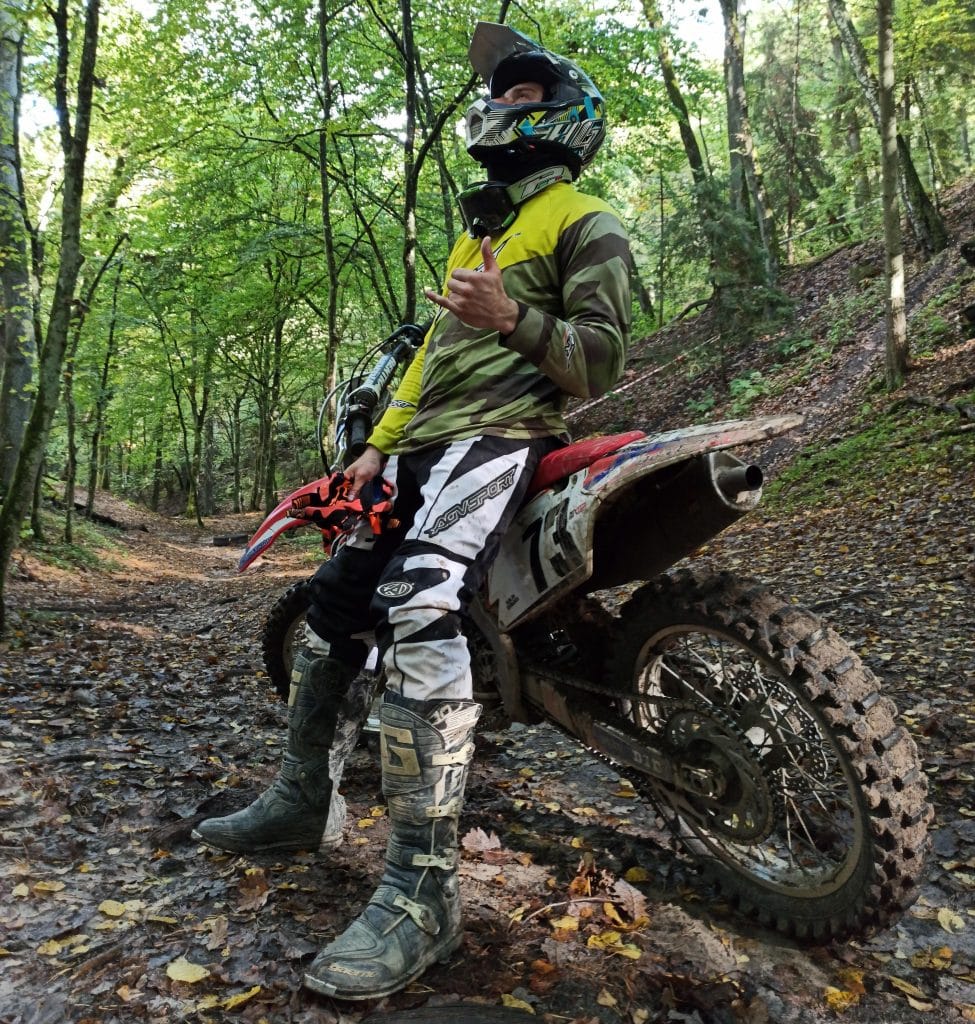
For dedicated off-road enthusiasts, the adventure unfolds where the pavement fades away. Off-road or motocross tires are meticulously crafted for exclusive dirt usage, promising unparalleled performance across diverse terrains, including mud, gravel, dirt, or sand.
Specialized Construction for Optimal Traction
Characterized by an exceptionally knobby construction, these tires ensure exceptional traction in the soft terrains typical of enduro or motocross riding. They are purpose-built for dirt, with encounters on pavement limited to transport via trailer or truck bed.
Choose tall, spaced-out knobs for soft terrain, acting as a scoop to prevent mud accumulation. For hard terrain, go for low, closely-clustered knobs to maximize surface area and grip, ensuring optimal off-road performance.
Versatile Tread Design
Extending beyond central knobs, the tread pattern wraps the sides of the tire at an angle. The unique configuration empowers riders to maintain exceptional grip while navigating sharp berms with soft surfaces.
Deep Treads for Enhanced Traction
Unlike biased road tires with shallow treads, off-road tires boast pronounced knob-like protrusions on their surfaces. These deep treads enable the tires to dig into loose surfaces, allowing the motorcycle to propel itself forward. The hard compound rubber, featuring reinforced sidewalls, protects the projections from cuts when encountering rough surfaces.
Despite their rugged construction, off-road tires are not intended for road use and wear out quickly when used on pavement, especially true for high-performance off-road tires, which tend to lose their tread rapidly on tar.
Merits:
- Specialized Traction: Tailored for exceptional traction in specific off-road terrains.
- Terrain-Optimized Construction: Different designs for soft and hard terrains cater to varied off-road disciplines.
- Performance Precision: Enables riders to maintain control and grip during challenging off-road maneuvers.
Drawbacks:
- Limited On-Road Usability: Strictly designed for off-road use, offering minimal performance on paved surfaces.
- Terrain-Specific: Tires optimized for one type of terrain may not perform as well in others.
Here are the standard metric sizes for off-road tires, both front and rear:
| Front Size | Alpha | Inch | Rear Size | Alpha | Inch |
|---|---|---|---|---|---|
| 80/90 | MH | 2.50/2.75 | 110/90 | MP85 | 4.50/4.75 |
| 90/90 | MJ90 | 2.75/3.00 | 120/90 | MR90 | 4.50/4.75 |
| 100/90 | MM90 | 3.25/3.50 | 130/80 | ---- | 5.00/5.10 |
| 110/90 | MN90 | 3.75/4.00 | 130/90 | MT90 | 5.50/6.00 |
| 120/80 | ---- | 4.25/4.50 | 140/80 | ---- | 5.50/6.00 |
| 120/90 | MR90 | 4.25/4.50 | 150/80 | MU90 | 6..00/6.25 |
| 130/90 | MT90 | 5.00/5.10 | 150/90 | MV85 | 6.00/6.25 |
8. Racing Tires/Slicks: Unleashing Precision

Racing tires, commonly known as slicks, are reserved solely for professional motorcycle racing unlike their road-going counterparts, delivering unmatched performance on the track.
The Soft Compound Secret
Made from the highest quality soft compound rubber, racing tires offer an unparalleled grip that allows racers to lean their motorcycles to physics-defying angles. This superior grip is essential for achieving precision and control at high speeds on the racing circuit.
Treadless Precision
Distinguishing themselves from conventional tires, slicks typically lack tread lines. An intentional design choice that focuses on maximizing the contact patch with the track at all times, ensuring optimal grip and maneuverability.
High-Temperature Mastery
They’re also are engineered to excel in high-temperature environments, a common occurrence during aggressive track use. The aggressive nature of racing quickly elevates tire temperatures, and these racing tires are designed to maintain exceptional grip under such conditions.
Ultra-Soft but Short-Lived
While the ultra-soft compound rubber on racing tires provides phenomenal grip, it comes with a trade-off. Unfortunately, they wear out rapidly, often lasting for just a single race or two. The sacrifice of longevity is a testament to the uncompromising pursuit of performance in the world of professional motorcycle racing.
Merits:
- Maximized Grip: Unmatched grip levels, crucial for high-speed racing maneuvers.
- Tailored for High Temperatures: Excel in aggressive track conditions with rapidly increasing tire temperatures.
Drawbacks:
- Limited Lifespan: The ultra-soft compound rubber wears out quickly, often lasting for only a race or two.
- Not Suitable for Road Use: Due to their specialized design, racing tires aren’t intended for on-road applications.
Michael’s Summary and Conclusion

I've diligently categorized my motorcycle gear recommendations into all available categories, with the aim of providing you with a comprehensive analysis that showcases the absolute best options for all your needs. These items are the culmination of in-depth research, extensive testing, and personal use throughout my vast experience of 50+ years in the world of motorcycling. Besides being a passionate rider, I've held leadership positions and offered consultancy services to reputable companies in over 25 countries. To See Top Picks and the Best Prices & Places to Buy: Click Here! |
Information for this article was partially sourced and researched from the following authoritative government, educational, corporate, and non-profit organizations:
Ni/A













